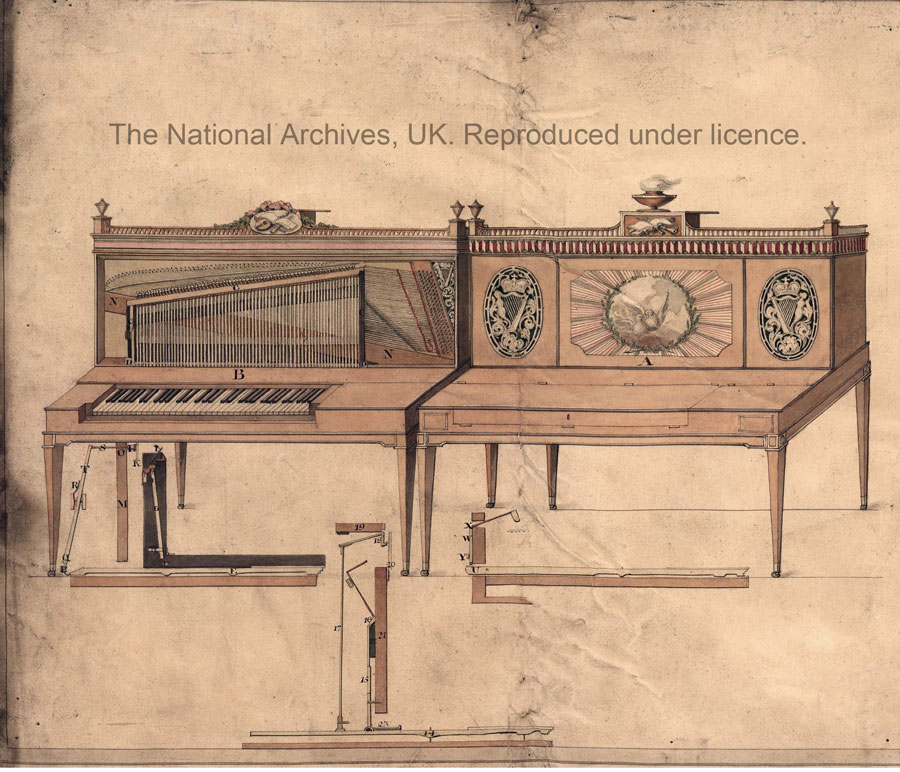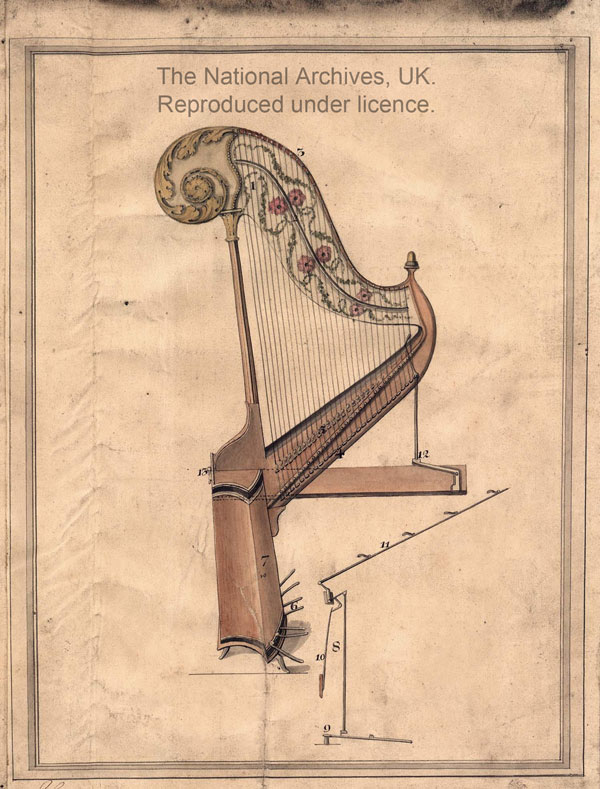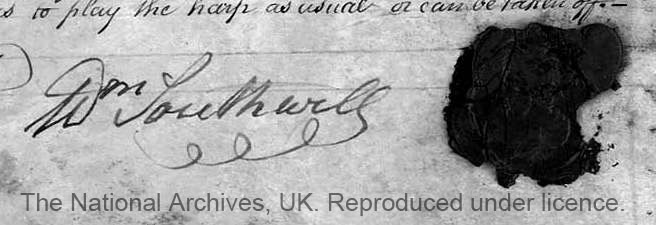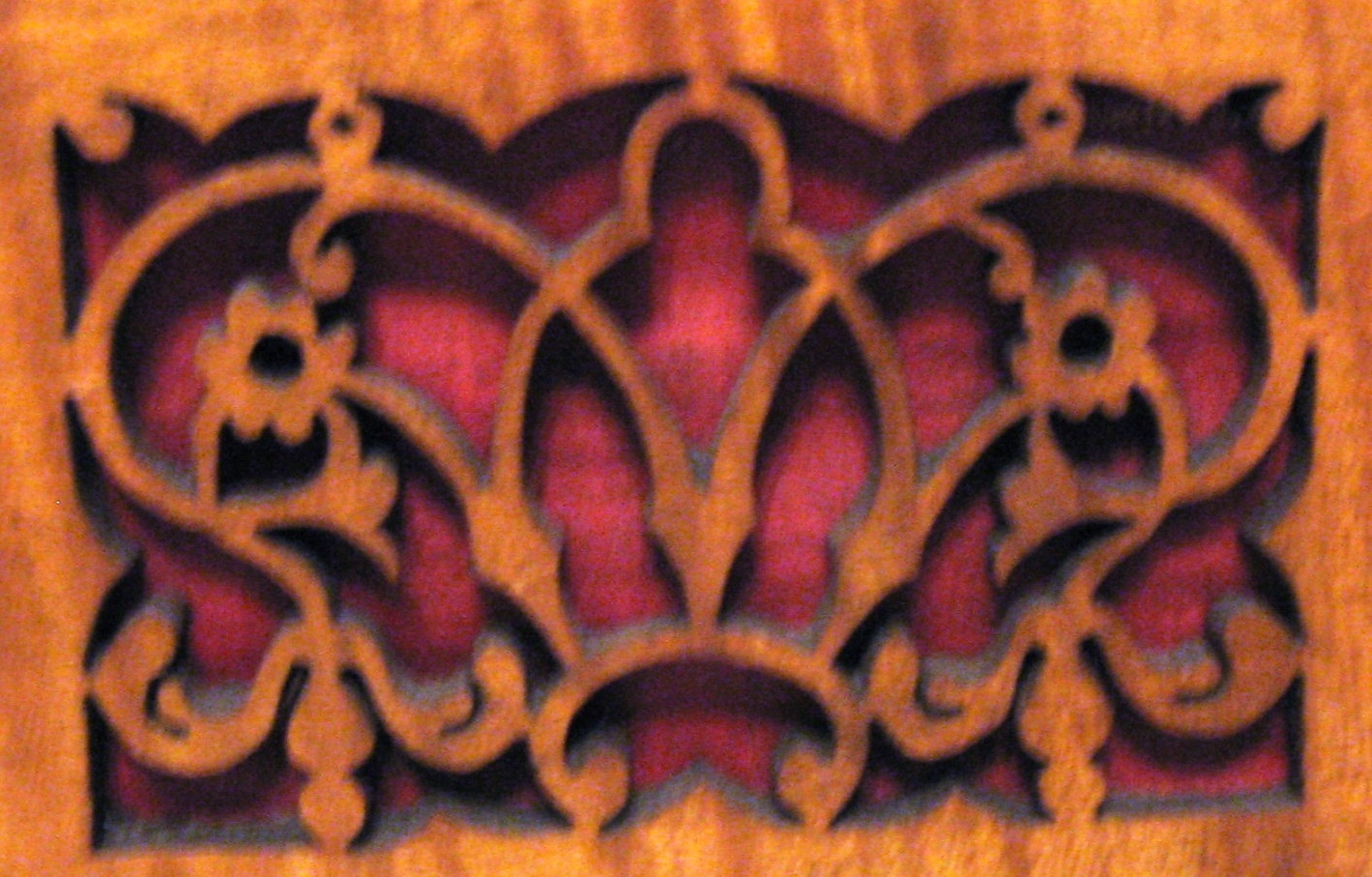William Southwell's Square Pianoforte and Harp Patent of 1798 (No. 2264)
The National Archives, UK, C217/90/3 and C210/65
Patent Drawings, C210/65
Patent Drawing, C210/65: Pianoforte

Patent Drawing, C210/65: Harp

Signature and Seal of William Southwell on C217/90/3

Transcription of the Specification
The National Archives, Kew: C217/90/3 – Original specification personally signed and sealed by William Southwell, dated 6 December 1798; text also repeated in the Patent Rolls, C210/65. [New lines in the original document are indicated by ‘/’ ]
To all to whom these presents shall come I William Southwell of Broad Court in the Parish of St Martin in the Fields in the County of Middlesex Musical Instrument–maker send Greeting Whereas His Most /
Excellent Majesty King George the third Did by His Letters patent under the Great Seal of Great Britain bearing date at Westminster the eighth day of November in the thirty ninth year of His Reign Give and Grant unto the said William /
Southwell His especial licence that I the said William Southwell during the term of years therein mentioned should and lawfully might use exercise and vend within England Wales and the Town of Berwick upon Tweed my Invention of /
certain new improvements on the action and construction of Piano Fortes and other musical Instruments In which said Letters Patent there is contained a Proviso obliging me the said William Southwell by an instrument in Writing /
under my hand and seal to cause a particular description of the nature of my said invention and in what manner the same is to be performed to be inrolled in His Majesty’s High Court of Chancery within one Calendar month next after the date of the /
said recited Letters Patent as in and by the same (Relation being thereunto had) may more fully and at large appear Now know ye – that in compliance with the said proviso of the said William Southwell do hereby declare that my said Invention of certain /
new improvements on the action and construction of Piano Fortes ~~ and other musical Instruments is described in the drawings hereunto annexed and the following description thereof as follows (that is to say) A. the Instrument at large B the section or front /
view of the inside. C.C.C is a frame that the hammer and leader are fastened to which leader is fastened to the hammer with a leather joint or any other material by this means the leader so [crossed out:] constructed [inserted:] connected [then:] with the hammer has a tendency by its weight to bring back the hammer after the /
stroke is given and for the convenience of putting on strings &c the before mentioned Frame C.C.C. turns down over the Keys with hinges marked D.D. a further description of the hammer and damper of the above instrument is described by a side view _ begin letter E which is the /
Key F is a button screw’d in the key to regulate the stroke of the hammer .G. the before mentioned leader to the Hammer .H. the socket for d.o _ I the hammer .K the strings it strikes .L. the damper _ M. a plank of wood [inserted:] about [then:] ¾ thick goes quite across the instrument under the strings – /
and connects with the sound board _ N. in the above drawing is a piece of Wood glued over all on the direction of the strings which is intended as a further strength by this means a bottom or back is not necessary except to preserve the inside work. O. is where a hole is made for the /
damper to go through P. is a button screw in the key and in its operation strikes against the wedge of the damper Q which gives its proper motion from the string R is a spring to bring it back _ S. is a small wire fastened to the leaver T._ a further description of a new method of adding /
additional notes to square or Horrizontal [sic] piano’s [sic] _ the key is marked U. which goes through the back of the instrument where the letter U. is marked _ and raises a leader of wood W. which leader has a leather or other joint fastened at the tale [sic] end of the hammer X. and of such /
a weight as to bring up the hammer without springs _ Y is a guide pin drove in the back and goes through a long hole in the leader _ Fig: 14 is the key of a new action of an upright piano _ 15 the leader to the hammer and hangs to it at fig 16 _ 17 is the leader to the /
damper _ 18 is the damper which is hanged to the Belly piece _ 19 the Belly piece _ the strings 20 _ 21 the restpiece 22 is the piece where the hammers are fastened and Slides with the hammer to one string without the keys _ 23 is to slide forward to disengage it from the /
hammer and by putting your feet on the peddal to raise the damper then you may take out the key as in common instruments _ description of a new invented harp _ described by fig: 1 is the Soundboard. 2 _ is the bridge _ which has holes board [sic] for the strings to /
pass through and is board [sic] on a different direction so as to make the string fast in the whole _ 3 is a row of ivory pins for the string to fasten to _ 4 is the turning pins _ No 5 is the hooks connected with the mechanical work to produce the half notes _ 6 is the peddals [sic] /
_ No 7 a door that opens to get to the springs and other parts of the iron work _ 8 is a sideview of the work of one peddal – 9 is where the end of the peddal turns on a centre to keep it to the half notes _ 10 a spring _ 11 is a streight [sic] bar or slip of brass where /
the different cranks for producing the half notes is connected _ 12 is one key leader and hammer shewing the above may be played with Keys _ 13 is the centre of which the entire Keys &ca turn round _ so as to play the harp as usual or can be taken off. /
In witness whereof I the said William Southwell have hereunto set my hand and seal this sixth day of December in the year of our Lord one thousand seven hundred and ninety eight _ /
(Signed and Sealed) Wm Southwell /
Taken and Acknowledged by the above named William Southwell this sixth day of December 1798 at the Public Office, before me /
John Simeon /
[Transcribed by Margaret and Michael Debenham; and by George Bozarth (versions cross-checked, 2008)]
Copyright © Margaret Debenham 2013-2019. All rights reserved.
Website design : Michael Debenham & Alexander Tse Debenham. Webmaster




